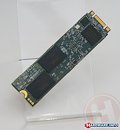- Joined
- Oct 9, 2007
- Messages
- 47,674 (7.43/day)
- Location
- Dublin, Ireland
| System Name | RBMK-1000 |
|---|---|
| Processor | AMD Ryzen 7 5700G |
| Motherboard | Gigabyte B550 AORUS Elite V2 |
| Cooling | DeepCool Gammax L240 V2 |
| Memory | 2x 16GB DDR4-3200 |
| Video Card(s) | Galax RTX 4070 Ti EX |
| Storage | Samsung 990 1TB |
| Display(s) | BenQ 1440p 60 Hz 27-inch |
| Case | Corsair Carbide 100R |
| Audio Device(s) | ASUS SupremeFX S1220A |
| Power Supply | Cooler Master MWE Gold 650W |
| Mouse | ASUS ROG Strix Impact |
| Keyboard | Gamdias Hermes E2 |
| Software | Windows 11 Pro |
In addition to its 2.5-inch SATA 6 Gb/s TLC NAND flash SSD, Plextor showed off its upcoming SSD in the NGFF form-factor, designed for next-generation Ultrabooks. Based on the same Marvell 88SS9189 processor and triple-level cell (TLC) NAND flash memory as its 2.5-inch cousin, the drive differs in being a 42 x 22 mm (LxW) NGFF module, with PCI-Express 2.0 x2 interface. The drives will be sold in 128 GB and 256 GB capacities, featuring 256 MB and 512 MB DDR3 DRAM caches, respectively. On offer are read speeds of up to 700 MB/s, writes of up to 550 MB/s, and maximum 4K random write performance of 100,000 IOPS. The NGFF drives should arrive around the same time as Ultrabooks based on 4th generation Core "Haswell" processors.

View at TechPowerUp Main Site

View at TechPowerUp Main Site







